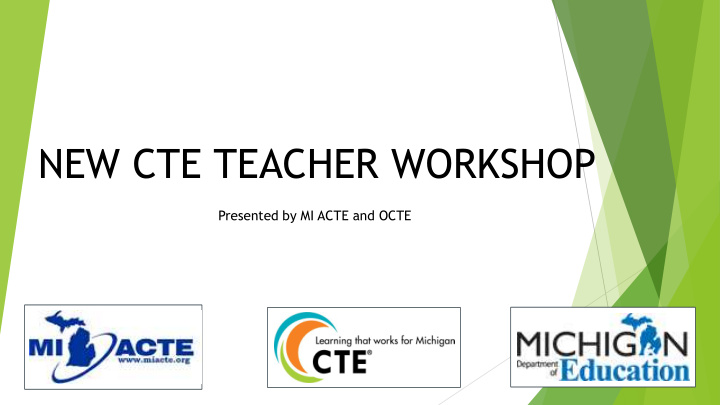



NEW CTE TEACHER WORKSHOP Presented by MI ACTE and OCTE
WELCOME and INTRODUCTIONS
New CTE Teacher Technical Tool Kit Guidance for New Teachers in CTE • Quick Reference Guide to Important CTE Information • • Sample Documents, Support Materials, Other Resources
Core Components in all CTE Programs
Core Components in all CTE Programs
What Makes CTE Unique and Relevant? CTE Program Requirements • Program Teacher Certification • Program Teacher Professional Development Program Advisory Committee: Industry Experts Providing Input to the Program • Implementation of Program Standards/Course Content • Strategies to Eliminate Barriers to Program Access • • Secondary-Postsecondary Connections
Michigan Center for CTE (MCCTE) Navigator www.ctenavigator.org
Academics in CTE
What is Classroom Management? Teacher Advice: Classroom Management Video
What is Classroom Management? GROUP ACTIVITY • At your table, share two effective classroom management strategies. • Appoint two people from your group and have each person share a best strategy from the table discussion.
Small Group Presentations • Program Advisory Committee Tool Kit Program and Instructional Design • Syllabus • Work-Based Learning (WBL) • • Leadership and Career and Technical Student Organization (CTSO) • Special Populations Students (SPOPS)
Small Group Presentation Program Advisory Committee Tool Kit Mark Forbush
Program Advisory Committee Tool Kit When you think of Advisory Committee - THINK PROGRAM ADVOCACY!
Program Advisory Committee Tool Kit Give members something to do. • • Program advisory committee members will… need to feel more engaged than just listening to a report. o need to have ownership. o be your best community advocate. o connect you with resources for your program. o Involvement will increase program advisory committee attendance.
Program Advisory Committee Requirements Program advisory committee chair must be from business • and industry.Membership must include representatives from the appropriate program-specific business, industry, and postsecondary representation, and a parent representative. The majority of the membership must be from business and • industry. Representation on the committee should reflect persons • from all genders, and racial and ethnic minorities represented within the community. • Additional non-voting members may include administrators, counselors, students, academic teachers, or a Special Populations SPOPS coordinator.
Program Advisory Committee REQUIRED DOCUMENTATION • Committee Roster • Meeting Agenda • Meeting Minutes Reference Program Advisory Committee Tool Kit for sample documentation.
Small Group Presentation Program and Instructional Design Tom Knight
Program and Instructional Design A CTE program is a sequence of courses • • Each CTE program is composed of 12 curricular segments Segments consists of standards and performance elements defined • in the program gap analysis CTE students are identified as Participants/Enrollees, • Concentrators, Completers based on the number of completed segments Participant/Enrollee – completes 6 or fewer segments of a program • • Concentrator – successfully completes with a C or better 7 but fewer than 12 segments of a program • Completer – successfully completes with a C or better all 12 segments of a program
Gap Analysis Document • 12 Segments Students are expected to demonstrate to the Performance • Element level.
Small Group Presentation Syllabus Tom Knight
Syllabus Course title • Instructor’s name and school contact information • Course dates • • Course description • Special features of the course Academic Credits o Postsecondary Connections o Available Certifications and or Licensures o Off-site Delivery o Work-Based Learning o Safety Training o Student Leadership (CTSO) opportunities o
Syllabus Course Outline with topics to be covered and CTE segments to be • covered in the course. Resources • Textbooks o Software o Special facilities o Materials o Reference New CTE Teacher Technical Tool Kit for sample documentation.
Small Group Presentation Work-Based Learning (WBL) Dana Hughes
Work-Based Learning
Work-Based Learning Opportunities One work-based learning opportunity for each student in the • program • Per the CTE Administrative Manual (2017) opportunities may include • Workplace Tour/Field Trip to program specific business/industry • Job Shadow Volunteering • Mentoring • See the Michigan Career Placement Association website for additional work-based learning information.
Work-Based Learning Documentation
Small Group Presentation Leadership and Career and Technical Student Organization (CTSO) Candice Vinson
Important Concepts for Student Leadership Communications and Speaking to Groups • Managerial Leadership Skills • • Personal Development • Career Success
Student Leadership/CTSO Checklist
Small Group Presentation Special Populations Students (SPOPS) Lee Greenacre
Special Populations Students Student who have special learning needs are considered special populations students in CTE and are defined by Perkins IV as: • Individuals with disabilities • Individuals from economically disadvantaged families, including foster children • Individuals preparing for nontraditional training and employment • Single parents, including single pregnant women • Displaced homemakers • Individuals with Limited English Proficiency (LEP)
Special Populations Students Individualized Education Program/Plan (IEP) The Individual with Disabilities Education Act (IDEA) is a federal law that makes available a free appropriate public education to children found eligible of having a disability. IEPs are created for youth who face challenges such as academic and/or economic disadvantages/disabilities. An IEP outlines required accommodations to assist your student to be successful. An instructor is legally responsible to follow the accommodations in an IEP.
Special Populations Students Section 504 Plan Section 504 is a civil rights law that prohibits discrimination against individuals with disabilities not identified as IEPs. A student with a 504 plan, may require accommodations and modifications.
Wrap-Up and Questions Workshop Survey
Resources – Found at MI ACTE Site Workshop Agenda Workshop PowerPoint Slides • Career Clusters and CIP Codes by Consultant • CEPD Map • CIP Self Review • CTE Administrator Manual • New CTE Teacher Technical Tool Kit • PD Calendar • Program Advisory Tool Kit • State Recognized CTSOs by Cluster and CIP Code
Resources MI ACTE www.miacte.org Michigan Department of Education, Office of CTE www.Michigan.gov/octe Michigan Center for CTE (MCCTE) www.ctenavigor.org Michigan Career Placement Association www.Micareerplacement.org
Recommend
More recommend